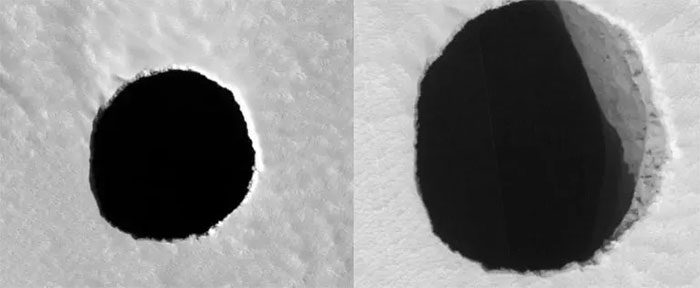The mysterious pit captured by NASA’s Mars Reconnaissance Orbiter (MRO) may be what scientists have long been searching for.
For a long time, extraterrestrial base projects on the Moon and Mars have focused on studying locations where humans could take shelter against harsh cosmic radiation.
This is also of interest to astrobiologists. In worlds that lack a strong atmosphere like Earth, cosmic impacts hinder the development of life.
There is one place that could address this issue: caves formed from ancient lava tubes.

The mysterious pit on Mars – (Photo: NASA).
According to Universe Today, the image of a strange hole captured by NASA in the Arsia Mons region of Mars is expected to be an entrance to such a lava tube.
Arsia Mons is one of the three inactive volcanoes in the Tharsis Montes group on Mars.
Surrounding this volcanic cluster is a vast volcanic plain that stretches for thousands of kilometers. It is higher than the rest of Mars, with an average elevation of the plain exceeding the planet’s average elevation by about 10 km.
Clearly, this area has experienced volcanic activity in the past, and features like the pit are a direct result of ancient volcanic activity.

The Tharsis Montes region on Mars featuring three adjacent volcanoes and a vast volcanic plain – (Photo: NASA)
One thing that scientists are still uncertain about is whether this pit is merely a shallow depression like certain sinkholes recorded in Hawaii on Earth.
The reflection of light on one side of the pit has raised this doubt, as it may suggest that the pit isn’t actually deep and doesn’t extend below as scientists hope.
However, NASA’s analyses also indicate that given Mars’s relatively weak gravity, it’s not surprising that its lava tubes are not as grand or complex as those on Earth.
Lava tubes on Earth often have a temperate environment and various chemical components that microorganisms can exploit as a source of life, potentially even containing water.
Thus, this could be where future NASA missions and other space agencies might aim, as Mars is also one of the planets most expected to harbor life, including ancient life and possibly even extremophiles that still exist today.





















































